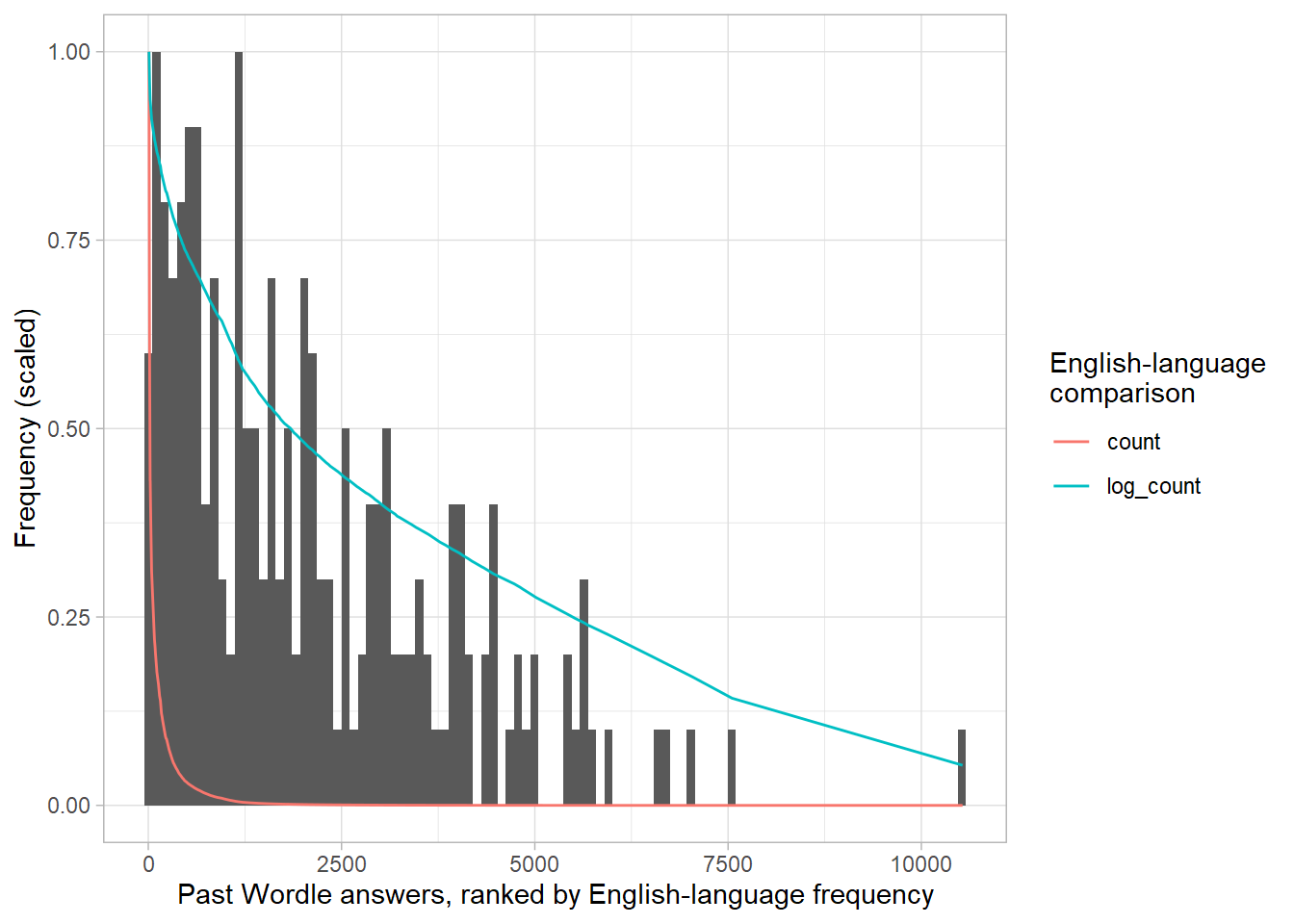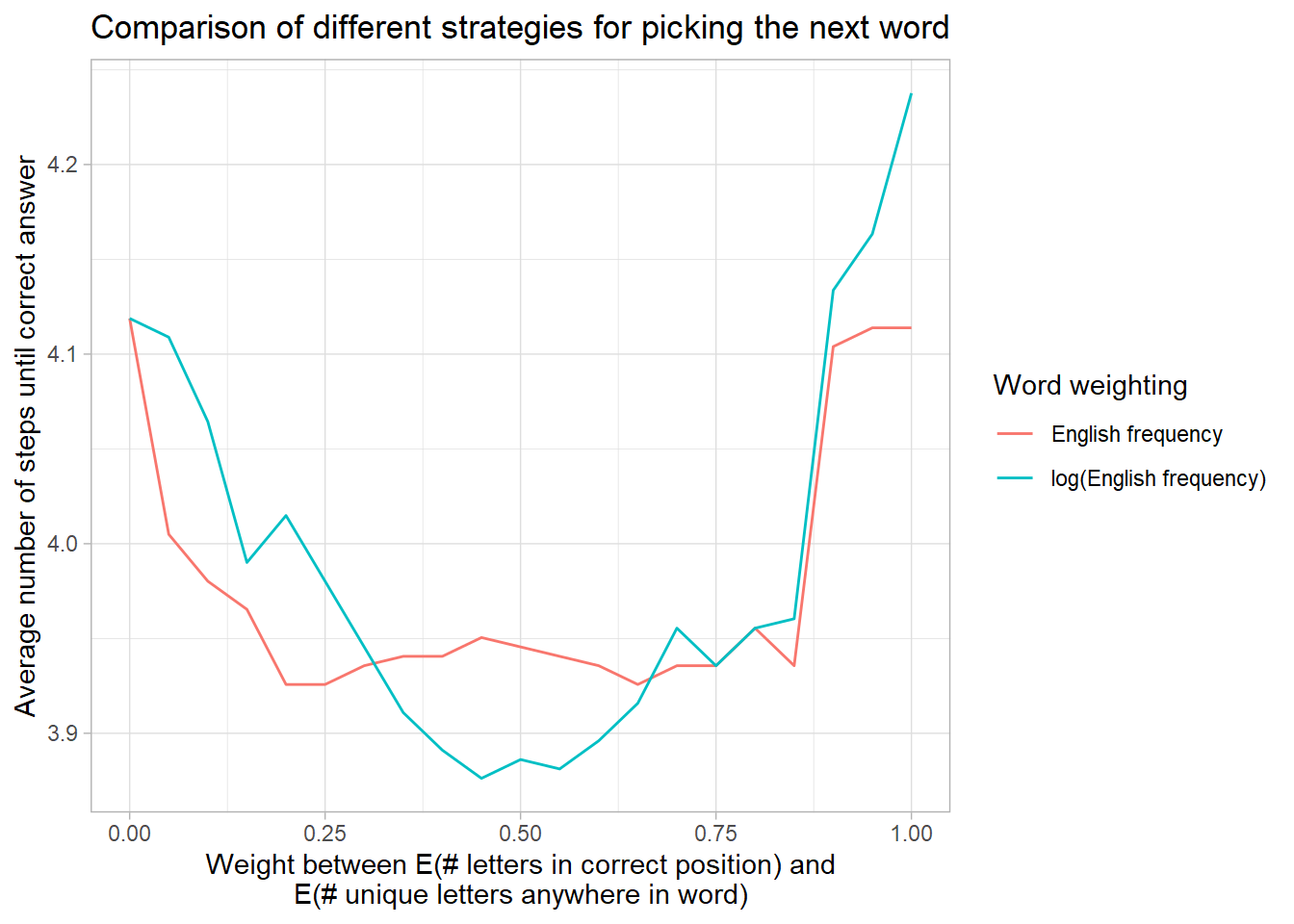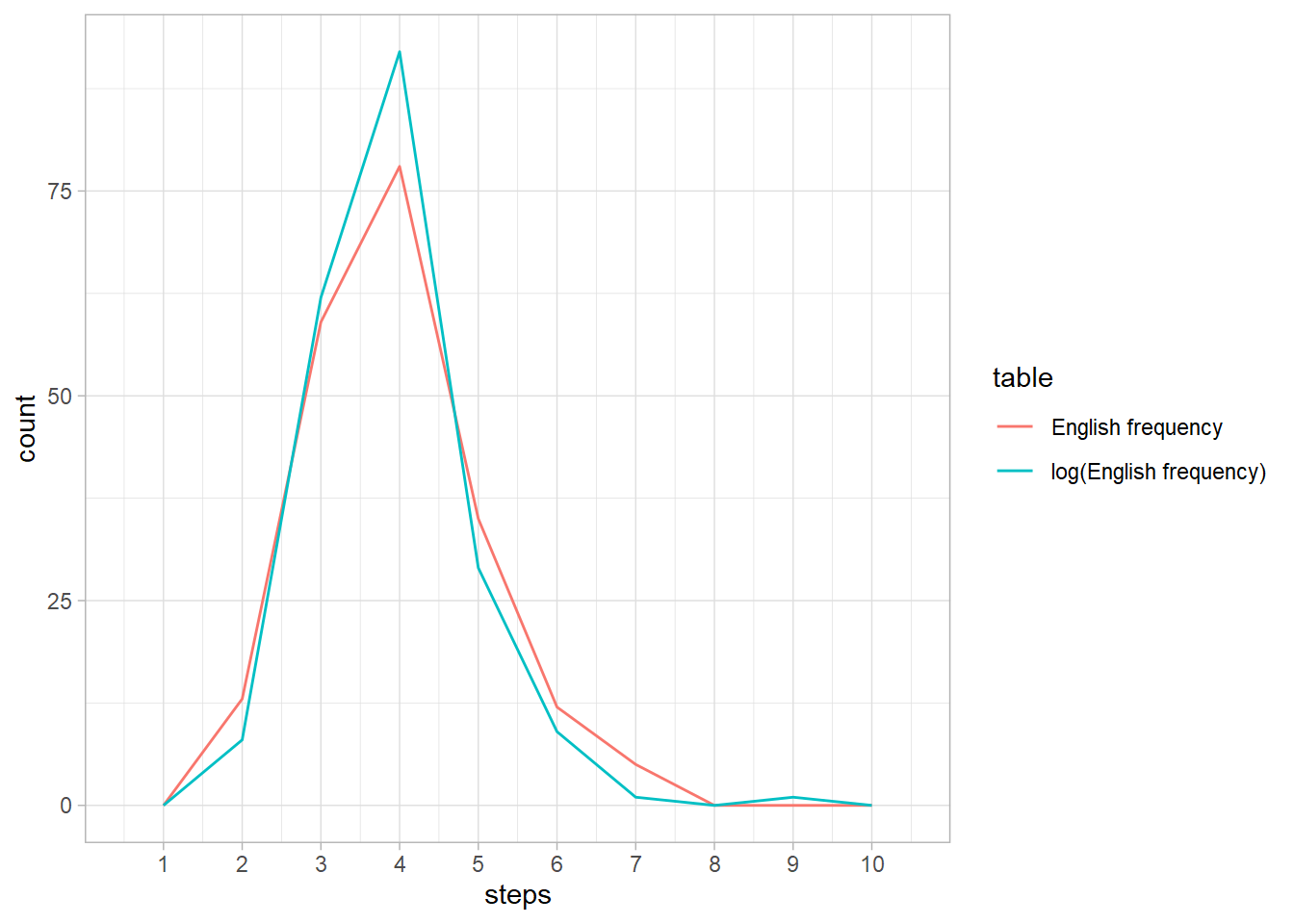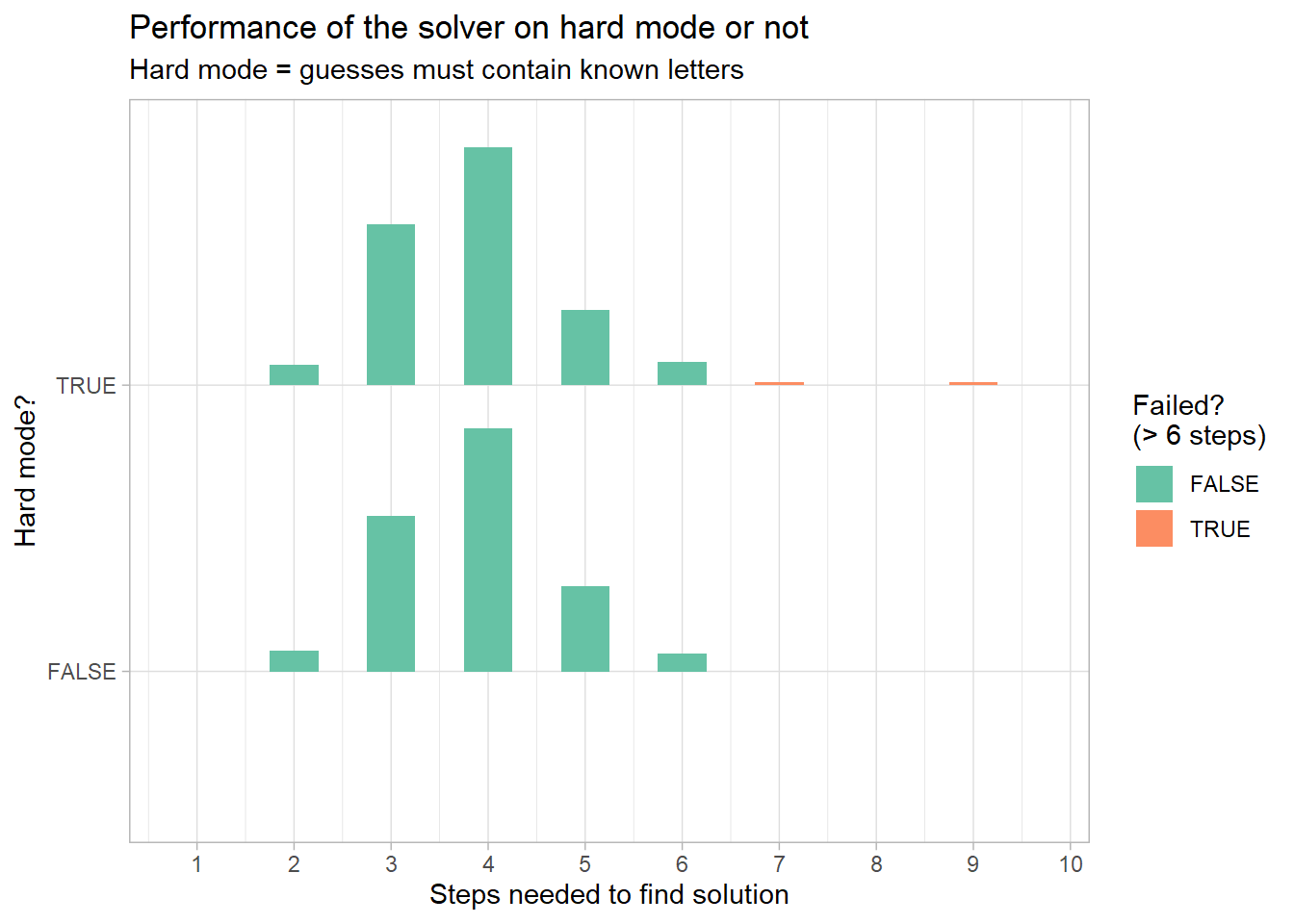Matthew Kay
In this document I play around with solving Wordles automatically. Probably the strategy I came up with is silly, but it seems to do an okay job, so I figured I’d write this up!
I rely heavily on coolbutuseless’s wordle package.
Packages needed:
library(dplyr)
library(tidyr)
library(purrr)
library(ggplot2)
# install via devtools::install_github("coolbutuseless/wordle")
library(wordle)
theme_set(theme_light())I’m going to take a pretty simple approach:
-
We’ll only look one word ahead at a time.
-
We’ll score words based on two things (essentially based on the green and yellow squares Wordle gives as feedback):
-
equal_score: The expected number of letters in the word in the correct position, given the remaining possible words. -
in_score: The expected number of new letters found anywhere in the word, given the remaining possible words. In a previous version this was just the expected number of letters founds anywhere in the word, but I updated this heuristic to only look for new letters to promote exploration.
-
-
We’ll calculate these expectations assuming the words chosen by Wordle follow some distribution based on word frequencies in the English language (though actually we’ll check this too!).
-
We’ll also (later) introduce a heuristic for picking between these two scores when needed.
Given all that, our first step will be to get a frequency distribution of words to weight our expectations by.
Helpfully, the {wordle} package already includes the full dictionary
of 5-letter strings that Wordle considers to be “words”:
helper = WordleHelper$new(nchar = 5)
str(helper$words)## chr [1:12972] "aahed" "aalii" "aargh" "aarti" "abaca" "abaci" "aback" ...
Using two different data sources, let’s hack together a rough table of English word frequencies. Here I am using a corpus of commonly-used words from the Google Web Trillion Word Corpus and the BNC word frequency list, and just naively stuffing them together with equal weights:
freq = tibble(word = helper$words) %>%
left_join(read.csv("unigram_freq.csv"), by = "word") %>%
left_join(
read.csv("bnc_freq.csv") %>%
group_by(word) %>%
summarise(count = sum(count)),
by = "word"
) %>%
mutate(
count.x = ifelse(is.na(count.x), 0, count.x),
count.y = ifelse(is.na(count.y), 0, count.y),
count = count.x/sum(count.x) + count.y/sum(count.y),
# need a nonzero count for all words, so just assume words that don't
# appear at all are half as frequent as the least frequent appearing word
count = ifelse(count == 0, min(count[count != 0])/2, count),
# rough log of the count shifted above 0
# (we'll want this later)
log_count = log(count) - log(min(count)/2)
)
freq %>%
arrange(-count)## # A tibble: 12,972 x 5
## word count.x count.y count log_count
## <chr> <dbl> <dbl> <dbl> <dbl>
## 1 which 810514085 3719 0.0554 13.9
## 2 there 701170205 3278 0.0486 13.8
## 3 their 782849411 2608 0.0423 13.6
## 4 about 1226734006 1971 0.0420 13.6
## 5 would 572644147 2551 0.0383 13.5
## 6 other 978481319 1421 0.0317 13.4
## 7 could 302311431 1683 0.0241 13.1
## 8 these 541003982 1254 0.0229 13.0
## 9 first 578161543 1193 0.0228 13.0
## 10 after 372948094 1160 0.0192 12.9
## # ... with 12,962 more rows
I don’t know how Wordle words are picked, but a reasonable simplification might be to assume they follow some distribution that has some relationship to their frequency in English. So let’s compare the frequency of the past answers to their frequencies in English.
As it happens, you can grab past answers from the Wordle source code (and future answers! though we won’t do that). Answers so far are:
past_answers = c("cigar","rebut","sissy","humph","awake","blush","focal","evade","naval","serve","heath","dwarf","model","karma","stink","grade","quiet","bench","abate","feign","major","death","fresh","crust","stool","colon","abase","marry","react","batty","pride","floss","helix","croak","staff","paper","unfed","whelp","trawl","outdo","adobe","crazy","sower","repay","digit","crate","cluck","spike","mimic","pound","maxim","linen","unmet","flesh","booby","forth","first","stand","belly","ivory","seedy","print","yearn","drain","bribe","stout","panel","crass","flume","offal","agree","error","swirl","argue","bleed","delta","flick","totem","wooer","front","shrub","parry","biome","lapel","start","greet","goner","golem","lusty","loopy","round","audit","lying","gamma","labor","islet","civic","forge","corny","moult","basic","salad","agate","spicy","spray","essay","fjord","spend","kebab","guild","aback","motor","alone","hatch","hyper","thumb","dowry","ought","belch","dutch","pilot","tweed","comet","jaunt","enema","steed","abyss","growl","fling","dozen","boozy","erode","world","gouge","click","briar","great","altar","pulpy","blurt","coast","duchy","groin","fixer","group","rogue","badly","smart","pithy","gaudy","chill","heron","vodka","finer","surer","radio","rouge","perch","retch","wrote","clock","tilde","store","prove","bring","solve","cheat","grime","exult","usher","epoch","triad","break","rhino","viral","conic","masse","sonic","vital","trace","using","peach","champ","baton","brake","pluck","craze","gripe","weary","picky","acute","ferry","aside","tapir","troll","unify","rebus","boost","truss","siege","tiger","banal")Let’s see if we can figure out how they relate to the frequency distribution of words in English.
Here are the frequencies of the selected words compared to their frequencies in English and the scaled log of their frequencies:
freq %>%
mutate(count_rank = rank(-count)) %>%
filter(word %in% past_answers) %>%
ggplot(aes(x = count_rank)) +
geom_histogram(aes(y = stat(ncount)), bins = 100) +
geom_line(aes(y = count, color = method), data = . %>%
pivot_longer(c(count, log_count), names_to = "method", values_to = "count") %>%
group_by(method) %>%
mutate(count = count/max(count))
) +
labs(
x = "Past Wordle answers, ranked by English-language frequency",
y = "Frequency (scaled)",
color = "English-language\ncomparison"
)It would appear that the probability of a word being chosen is closer to the log of its frequency than its actual frequency. This is probably a sensible word selection strategy for making a good game, since it makes the puzzle not just a bunch of very common words (but also not just a bunch of rare words). So we may want to weight expectations by log frequency, not frequency (we’ll actually try both and see).
In the meantime, we’ll keep both the frequency and log frequency as lookup tables for later…
english_freq_table = freq$count
names(english_freq_table) = freq$word
english_log_freq_table = freq$log_count
names(english_log_freq_table) = freq$wordHere’s a relatively naive scoring function for possible guesses. It looks at every possible word and scores it according to a weighted sum of two expectations: the expected number of letters in the correct position and the expected number of new letters discovered to be in the word (i.e. letters that weren’t already known about). It calculates expectations over a provided frequency distribution of possible words.
score_words = function(helper, weight = 0.5, freq_table = english_log_freq_table, guess_words = NULL, explore_threshold = NA) {
words = helper$words
# get word frequencies
word_freq = if (is.null(freq_table)) {
rep(1, length(words))
} else{
freq_table[words]
}
word_freq = word_freq / sum(word_freq)
# matrix of letters in each word
word_letters = strsplit(words, "")
word_letters_matrix = simplify2array(word_letters)
# words to be used for guessing --- if not provided, assume we're doing "hard mode";
# i.e. can only guess from the remaining possible words
if (is.null(guess_words)) {
guess_words = words
guess_word_letters = word_letters
guess_word_letters_matrix = word_letters_matrix
} else {
guess_word_letters = strsplit(guess_words, "")
guess_word_letters_matrix = simplify2array(guess_word_letters)
}
# first part of score: expected number of letters in the correct position
equal_score = vapply(guess_word_letters, \(w) sum(colSums(w == word_letters_matrix) * word_freq), numeric(1))
# second part of score: expected number of new letters discovered to be in the word
known_letters = union(unlist(strsplit(helper$wrong_spot, "")), helper$exact)
unknown_letters = setdiff(letters, known_letters)
word_letters_mask_matrix = vapply(word_letters, \(w) unknown_letters %in% w, logical(length(unknown_letters)))
guess_word_letters_mask_matrix = vapply(guess_word_letters, \(w) unknown_letters %in% w, logical(length(unknown_letters)))
in_score = colSums((word_freq * t(word_letters_mask_matrix)) %*% guess_word_letters_mask_matrix)
# if we have at least three similar "top" contenders according to equal_score
# "explore" for one round (this is off by default, we'll get to it later...)
sorted_equal_score = sort(equal_score, decreasing = TRUE)
if (
isTRUE(sorted_equal_score[1] / sorted_equal_score[3] < explore_threshold)
&& any(in_score > 0)
) {
weight = 0
}
tibble(words = guess_words, equal_score, in_score, score = weight*equal_score + (1 - weight)*in_score) %>%
arrange(-score)
}For example, we can ask it for an initial guess by scoring all possible words given that we have made no guesses so far:
score_words(helper, guess_words = wordle_dict)## # A tibble: 12,972 x 4
## words equal_score in_score score
## <chr> <dbl> <dbl> <dbl>
## 1 tares 0.791 1.89 1.34
## 2 lares 0.772 1.88 1.33
## 3 rales 0.748 1.88 1.31
## 4 rates 0.733 1.89 1.31
## 5 nares 0.747 1.86 1.30
## 6 cares 0.806 1.80 1.30
## 7 tales 0.767 1.82 1.29
## 8 dares 0.776 1.81 1.29
## 9 pares 0.792 1.77 1.28
## 10 tores 0.780 1.78 1.28
## # ... with 12,962 more rows
So it suggests “tares” as a first word to try. Let’s play against a particular word and see how many steps it takes to get it:
play_against = function(word, first_guess = NULL, quiet = FALSE, ...) {
helper = WordleHelper$new(nchar = nchar(word))
game = WordleGame$new(helper$words, target_word = word)
if (!is.null(first_guess)) {
helper$update(first_guess, game$try(first_guess, quiet = quiet))
}
while (!game$is_solved()) {
guess = score_words(helper, ...)$words[[1]]
helper$update(guess, game$try(guess, quiet = quiet))
}
game$attempts
}Let’s try it out:
play_against("slump")## [38;5;232m[48;5;249m t [48;5;249m a [48;5;249m r [48;5;249m e [48;5;226m s [39m[49m
## [38;5;232m[48;5;46m s [48;5;249m o [48;5;249m i [48;5;226m l [48;5;249m y [39m[49m
## [38;5;232m[48;5;46m s [48;5;46m l [48;5;46m u [48;5;46m m [48;5;46m p [39m[49m
## [1] "tares" "soily" "slump"
(This doesn’t seem to render properly in Github markdown, so here’s a screenshot:)
Not bad!
There are two obvious parameters here: the weight between the two
expectations and the word frequency table used. Let’s try both in
various combinations:
strategy_steps =
map_dfr(list(freq = english_freq_table, log_freq = english_log_freq_table), .id = "table", \(freq_table) {
map_dfr(seq(0, 1, length.out = 21), \(weight) {
cat("Scoring weight = ", weight, "\n")
# get the first guess here since it takes the longest
first_guess = score_words(WordleHelper$new(nchar = nchar(past_answers[[1]])), weight = weight)$words[[1]]
map_dfr(past_answers, \(word) data.frame(
word,
weight,
steps = tryCatch(
length(play_against(
word, first_guess = first_guess,
weight = weight, freq_table = freq_table,
quiet = TRUE
)),
error = function(e) NA
)
))
})
})Comparing the the various strategies…
strategy_steps %>%
mutate(table = forcats::fct_recode(table,
"English frequency" = "freq",
"log(English frequency)" = "log_freq"
)) %>%
group_by(weight, table) %>%
summarise(steps = mean(steps, na.rm = TRUE), .groups = "drop") %>%
ggplot(aes(weight, steps, color = table)) +
geom_line() +
labs(
title = "Comparison of different strategies for picking the next word",
x = "Weight between E(# letters in correct position) and\nE(# unique letters anywhere in word)",
color = "Word weighting",
y = "Average number of steps until correct answer"
)It seems like an equal weight between both expectations (using the log frequency table) is not too shabby.
Looking in more detail at the distribution of numbers of steps when
weight == 0.5, it looks like using the log frequency weighting only
offers a very slight improvement overall:
strategy_steps %>%
mutate(table = forcats::fct_recode(table,
"English frequency" = "freq",
"log(English frequency)" = "log_freq"
)) %>%
filter(weight == 0.5) %>%
ggplot(aes(x = steps, color = table)) +
geom_freqpoly(binwidth = 1, na.rm = TRUE) +
scale_x_continuous(breaks = 1:10)One thing that is problematic is that there remain some words that require more than 6 guesses (which is a “loss” in Wordle). Let’s see if we can fix that…
Wordle’s default “easy mode” allows you to guess words that don’t contain the letters you’ve found so far. The solver by default plays on “hard mode”, but we can let it play on “easy mode” by tweaking two parameters:
-
Setting
guess_wordsdetermines the dictionary used for guesses. By default the remaining possible words are used (i.e. the words containing the letters found so far). By settingguess_wordsto the full dictionary (wordle::wordle_dict), we can allow the solver to guess any word in any round. -
Setting
explore_thresholdto a value greater than 1 will allow the solver to trigger the “explore” mode. In a given round, if the ratio ofequal_score(the expected number of correct letters) between the highest-ranked guess according toequal_scoreand the third-highest-ranked guess is less thanexplore_threshold, thenequal_scoreis ignored andin_score(the expected number of new letters found) is used by itself for that round. The idea here is that if the top three words all have similar likelihood of being correct, it’s better to try a different, single word that might distinguish between those three (taking two rounds: the “exploration” guess plus guessing the remaining word) than needing to guess all three words. I’ve found a value of1.01words well for this parameter, but haven’t played with it deeply.
You can see the difference by picking one of the particularly bad words from “hard mode”. For example:
strategy_steps %>%
filter(weight == 0.5, table == "log_freq") %>%
arrange(-steps) %>%
head(10)## table word weight steps
## 1 log_freq hatch 0.5 9
## 2 log_freq surer 0.5 7
## 3 log_freq evade 0.5 6
## 4 log_freq stool 0.5 6
## 5 log_freq floss 0.5 6
## 6 log_freq unfed 0.5 6
## 7 log_freq booby 0.5 6
## 8 log_freq crass 0.5 6
## 9 log_freq wooer 0.5 6
## 10 log_freq parry 0.5 6
Let’s look at “hatch”:
play_against("hatch")## [38;5;232m[48;5;226m t [48;5;46m a [48;5;249m r [48;5;249m e [48;5;249m s [39m[49m
## [38;5;232m[48;5;249m n [48;5;46m a [48;5;46m t [48;5;46m c [48;5;46m h [39m[49m
## [38;5;232m[48;5;249m w [48;5;46m a [48;5;46m t [48;5;46m c [48;5;46m h [39m[49m
## [38;5;232m[48;5;249m m [48;5;46m a [48;5;46m t [48;5;46m c [48;5;46m h [39m[49m
## [38;5;232m[48;5;249m p [48;5;46m a [48;5;46m t [48;5;46m c [48;5;46m h [39m[49m
## [38;5;232m[48;5;249m b [48;5;46m a [48;5;46m t [48;5;46m c [48;5;46m h [39m[49m
## [38;5;232m[48;5;249m l [48;5;46m a [48;5;46m t [48;5;46m c [48;5;46m h [39m[49m
## [38;5;232m[48;5;249m c [48;5;46m a [48;5;46m t [48;5;46m c [48;5;46m h [39m[49m
## [38;5;232m[48;5;46m h [48;5;46m a [48;5;46m t [48;5;46m c [48;5;46m h [39m[49m
## [1] "tares" "natch" "watch" "match" "patch" "batch" "latch" "catch" "hatch"
The solver does a poor job, because it is stuck guessing words that end in “atch”, and the solution (“hatch”) happens to be rarer than most of the other words ending in “atch”, so they are chosen first.
By allowing the solver to dynamically “explore” when it has a set of similarly-likely candidate guesses, it is able to eliminate a bunch of potential “atch” words in a single guess:
play_against("hatch", explore_threshold = 1.01, guess_words = wordle_dict)## [38;5;232m[48;5;226m t [48;5;46m a [48;5;249m r [48;5;249m e [48;5;249m s [39m[49m
## [38;5;232m[48;5;249m n [48;5;46m a [48;5;46m t [48;5;46m c [48;5;46m h [39m[49m
## [38;5;232m[48;5;249m b [48;5;249m l [48;5;249m i [48;5;249m m [48;5;249m p [39m[49m
## [38;5;232m[48;5;249m w [48;5;46m a [48;5;46m t [48;5;46m c [48;5;46m h [39m[49m
## [38;5;232m[48;5;249m c [48;5;46m a [48;5;46m t [48;5;46m c [48;5;46m h [39m[49m
## [38;5;232m[48;5;46m h [48;5;46m a [48;5;46m t [48;5;46m c [48;5;46m h [39m[49m
## [1] "tares" "natch" "blimp" "watch" "catch" "hatch"
We can run this approach against the past answers…
helper = WordleHelper$new(nchar = 5)
first_guess = score_words(helper, explore_threshold = 1.01, guess_words = wordle_dict)$words[[1]]
explore_steps =
map_dfr(past_answers, \(word) {
cat("Scoring word ", word, "\n")
data.frame(
word,
steps = tryCatch(
length(play_against(
word, first_guess = first_guess,
explore_threshold = 1.01, guess_words = wordle_dict,
quiet = TRUE
)),
error = function(e) NA
)
)
})… and see how the “easy mode” approach with exploration compares to the “hard mode” approach:
strategy_steps %>%
filter(table == "log_freq", weight == 0.5) %>%
mutate(hard_mode = TRUE) %>%
bind_rows(mutate(explore_steps, hard_mode = FALSE)) %>%
ggplot(aes(y = hard_mode, x = steps, fill = stat(x > 6.5))) +
ggdist::stat_histinterval(
breaks = 2:20/2 - 0.25,
show_interval = FALSE,
scale = 0.85
) +
scale_x_continuous(breaks = 1:10) +
labs(
title = "Performance of the solver on hard mode or not",
subtitle = "Hard mode = guesses must contain known letters",
y = "Hard mode?",
x = "Steps needed to find solution",
fill = "Failed?\n(> 6 steps)"
) +
scale_fill_brewer(palette = "Set2")Very similar overall, except we got rid of those pesky > 6 step solutions!






